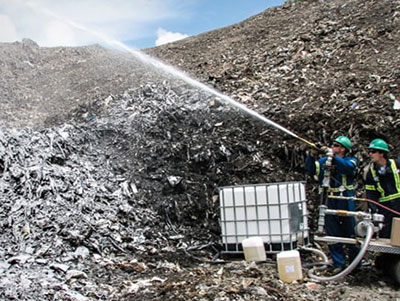Surface odour control involves using foaming odour neutralising concentrate to neutralise odours.
Eliminate noxious odours in a cost-effective, environmentally friendly way.
Surface odour control (also known as a surface treatment), means using an odour neutraliser concentrate to manage surfaces that generate noxious odours. Users apply the foaming applicator to problem surfaces, where the foam penetrates, allowing select micronutrients to direct the microbiology of the odour source.At Cleanawater, we use Bektra 830F Foaming Odour Neutraliser Concentrate which works in 3 steps:
At CleanaWater, we use Bektra 830F Foaming Odour Neutraliser Concentrate which works in 3 steps:
- The foaming application is blanketed over the problem area surface
- The 830F micronutrient blend applies to the odour-producing biological processes
- A powerful contact deodoriser immediately neutralises the odours
The concentrate is typically applied using a spray device, which can be operated easily by one person.
For product information see our surface treatments page.
What is the foaming odour neutralising concentrate made from?
The Bektra 830F foaming odour neutraliser concentrate is made of a micronutrient formulation.
This formulation is comprised of a blend of active ingredients:
- Essential oils
- Purines
- Minerals
- Amino acids
- Pyrimidines
- Vitamins
- Complex organic extracts
It provides a non-toxic and biodegradable method of neutralising odours, which assists with organic decomposition without creating odorous by-products. Additionally, it does not feature any bacteria, enzymes or hazardous chemicals.
Where is surface odour control used?
Surface odour control does not require any infrastructure to set up. One person with a spray device simply applies the foaming odour neutraliser concentrate to the problem area.

This makes this type of odour control a good choice for smaller organisations or for use in situations where a larger odour neutraliser system/infrastructure is not practical.
Common areas of application include:
- Landfill and rubbish dumps
- Composting operations
- Wastewater treatment centres
- Recycling plants
- Transfer stations
It is typically applied to tip faces, concrete driveways and loading areas, haulage vehicles, tipping floors and pits weight scales, spoil piles, as well as in rubbish and compactor rooms. Other hard surfaces include septic tanks, porta loos and long drop toilets. It can even be used to control leachate odours on liquid surfaces like ponds, drains, and lagoons without any risk to nature.
How surface treatments compare to misting systems
An alternative to surface odour control systems is odour neutralising misting systems. They also provide a powerful and commonly used method of odour control.
Misting systems utilise a reactant constructed from essential oils and surfactants. Surfactants being a substance that allows molecular binding through the process of lowering the surface tension of water. They neutralise odours by releasing airborne droplets that attract and eliminate odour particles.
The benefit of surface odour control compared to misting systems is that they require a lesser investment.
Misting options require new infrastructure, power, water and continuous application. This is a suitable solution in many cases. However, in circumstances where odour control needs to be temporary, flexible or lower in cost, surface treatments are typically a more practical option.
Additional information
Surface treatments neutralise odours and strong fragrances by reducing chemical oxygen demand (COD) levels and biochemical oxygen demand (BOD5). They provide an effective and convenient solution for managing both hydrogen sulfide (H₂S) and volatile organic compounds (VOCs).
They lower levels of sludge and solids in lagoons and other water sources, and also stop the production of noxious by-products caused by organic waste breakdown, thereby tackling odours at their source.
As with all odour management products supplied by CleanaWater, they are backed by our Workplace Health and Safety (WHS), Quality, and Environmental Management Systems accreditations.
Most recently we've used surface treatments to manage odourous soils at Barangaroo Development in Sydney and the Kooragang Island Road Duplification in Newcastle. As well as at the ANL composting facility on Sydney's Northern beaches and at various tips and waste transfer stations.
"Surface treatments provide a non-toxic and biodegradable method of neutralising odours."
Thinking surface odour control? Think CleanaWater.
At CleanaWater, we have over 25 years' experience in the control of odours and smells. Over that time we've helped countless businesses, organisations and operations to manage surfaces and their odour output.
We supply and manufacture technologies that are designed to help businesses meet regulatory compliance requirements and improve their bottom line. Our sustainable approach to the industry has the two-fold business benefits of long-term cost-effectiveness as well as achieving authority and regulatory compliance.
We have a team of experienced noxious odour specialists who are dedicated to helping businesses find the right solution for their needs.
To find out more about surface odour control and foaming odour neutraliser concentrate, or to purchase a foaming application system, speak with a CleanaWater odour specialist today.
Learn more about our surface treatment products.
Must Read
What to Expect During a Modular Wash Bay Installation
CleanaWater, we make the process of installing a modular wash bay on your site as smooth and straightforward as possible. ...
Read moreThe CleanaWater Team Driving Water Treatment and Sustainability
CleanaWater is powered by a dedicated team of professionals who bring expertise and passion to every project. ...
Read more